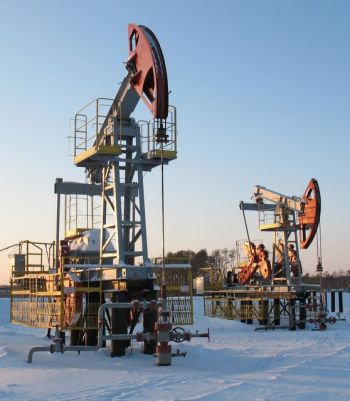Future Development
 Oil industry at work (Photo: GettyImages)The Arctic is expected to host around 22% of the world's remaining undiscovered oil and gas reserves, according to a 2008 assessment from the US Geological Survey. According to this assessment this would equal an estimated total oil and natural gas resource of 412 billion barrels of oil equivalent.
Oil industry at work (Photo: GettyImages)The Arctic is expected to host around 22% of the world's remaining undiscovered oil and gas reserves, according to a 2008 assessment from the US Geological Survey. According to this assessment this would equal an estimated total oil and natural gas resource of 412 billion barrels of oil equivalent.
According to the Energy Information Administration of the USA, the world total consumption of oil barrels per day in the year 2008 was 85.462, the yearly total being thus 31.193.630 billion barrels. This means that the whole world would be around 13 years to use all of the oil in the Arctic, should the whole 412 billion barrels be extracted and produced.
Around 78% of the Arctic resources are expected to be natural gas and natural gas liquids (NGL). The West Siberian Basin and East Barents Basin are estimated to be key areas, holding 47% of the total undiscovered resources. 94 percent of the resources within these areas are expected to be natural gas and NGL.
The North American part of the Arctic is expected to hold mostly oil whereas the Eurasian part of the Arctic seems to promise largely extended gas reserves: About 65% of the undiscovered Arctic oil are expected in the American part of the Arctic, compared to only 26% of the undiscovered Arctic natural gas.
The major share of undiscovered oil deposits is expected to be in Arctic Alaska: About 30 billion barrels. Second is the Amerasia Basin, just north of Canada, with an estimate of about 9.7 billion barrels of undiscovered oil and third the East Greenland Rift, which is estimated to hold about 8.9 billion barrels of undiscovered oil.
Altogether, these three North American provinces count for an expected sum of about 48.6 billion barrels of undiscovered oil, corresponding to around 54% of the total undiscovered oil in the Arctic.
In the Barents Sea recent findings indicate that the Skrugard field contains an estimated amount of 250 million barrel oil reserves. Another field, Goliat is currently under development with an estimated reservoir size of 240 million barrels. It is also expected oil reserves are laying around Greenland; however exploration and test drilling have not yet led to any findings.
Despite expected large reserves, the future of Arctic oil development is depending on technical, political and environmental challenges. Technical challenges are in general the harsh Arctic conditions that put special demands on men and material. Transport systems such as pipelines need to be constructed and in addition face technical challenges as climate change puts new requirements towards materials and construction technologies.
Possible sovereignty disputes over land and sea areas in the circumpolar North could also delay the development of future oil fields. Regional examples such as from the Barents Sea, show how a long-lasting delimitation dispute can hold development for many decades. It was not until the 7th of July 2011, the day the Norwegian-Russian delimitation treaty in the Barents Sea entered into force that the Norwegian side started immediate prospecting for oil and gas.
Last but not least there is the challenge of the vulnerable Arctic environment and the indigenous people of the circumpolar North that puts high demands to any oil or gas related project in the region. Increased transport, e.g. by tankers will also require new capabilities to Search and Rescue capabilities as well as oil spill prevention. High costs due to high environmental protection demands could delay or even halt a further development of Arctic oil, especially when cost / benefit calculations compare it with other regions.
An increasing oil price could make the exploitation of oil shale and oil sand reserves e.g. in subarctic regions more reasonable and feasible than an immediate offshore drilling in the Arctic Ocean or adjacent shelves. Still a growing global demand for energy and challenges with energy security e.g. in the Middle-East region can give additional momentum to develop Arctic oil despite the named challenges.
So despite an anticipated abundance of resources and a high demand, there are still high costs, high risks and lengthy lead-times to be expected that could potentially delay or even stall any further development of oil fields in the Arctic.
One has thus to be careful in predicting if and when a significant increase in Arctic oil production is to be expected in the future.
Sources: US Geological Survey Energy Information Administration UArctic Eurasia review UArctic








